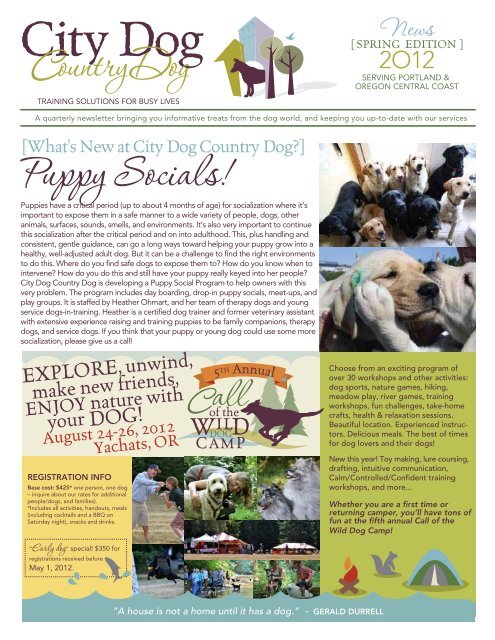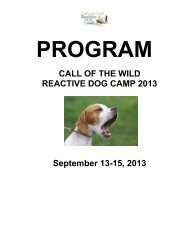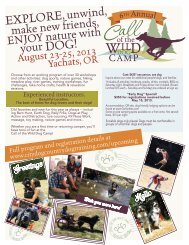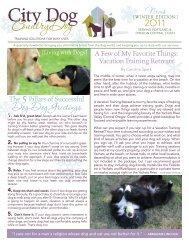Spring 2012 - City Dog Country Dog Training
Spring 2012 - City Dog Country Dog Training
Spring 2012 - City Dog Country Dog Training
You also want an ePaper? Increase the reach of your titles
YUMPU automatically turns print PDFs into web optimized ePapers that Google loves.
TRAINING SOLUTIONS FOR BUSY LIVESNews[ SPRING EDITION ]2O12SERVING PORTLAND &OREGON CENTRAL COASTA quarterly newsletter bringing you informative treats from the dog world, and keeping you up-to-date with our servicesPuppy[What’s NewSocials!at <strong>City</strong> <strong>Dog</strong> <strong>Country</strong> <strong>Dog</strong>?]Puppies have a critical period (up to about 4 months of age) for socialization where it’simportant to expose them in a safe manner to a wide variety of people, dogs, otheranimals, surfaces, sounds, smells, and environments. It’s also very important to continuethis socialization after the critical period and on into adulthood. This, plus handling andconsistent, gentle guidance, can go a long ways toward helping your puppy grow into ahealthy, well-adjusted adult dog. But it can be a challenge to find the right environmentsJOIN USto do this. Where do you find safe dogs to expose them to? How do you know when tointervene? How do you do this and still have your puppy really keyed into her people?<strong>City</strong> <strong>Dog</strong> <strong>Country</strong> <strong>Dog</strong> is developing a Puppy Social Program to help owners with thisvery problem. The program includes day boarding, drop-in puppy socials, meet-ups, andplay groups. It is staffed by Heather Ohmart, and her team of therapy dogs and youngservice dogs-in-training. Heather is a certified dog trainer and former veterinary assistantwith extensive experience raising and training puppies to be family companions, therapydogs, and service dogs. If you think that your puppy or young dog could use some moresocialization, please give us a call!EXPLORE, unwind,make new friends,ENJOY nature withyour DOG!August 24-26, <strong>2012</strong>Yachats, ORREGISTRATION INFOBase cost: $425* one person, one dog– inquire about our rates for additionalpeople/dogs, and families).*Includes all activities, handouts, meals(including cocktails and a BBQ onSaturday night), snacks and drinks.5 TH Annual5th AnnualChoose from an exciting program ofover 30 workshops and other activities:dog sports, nature games, hiking,meadow play, river games, trainingworkshops, fun challenges, take-homecrafts, health & relaxation sessions.Beautiful location. Experienced instructors.Delicious meals. The best of timesfor dog lovers and their dogs!New this year! Toy making, lure coursing,drafting, intuitive communication,Calm/Controlled/Confident trainingworkshops, and more...Whether you are a first time orreturning camper, you’ll have tons offun at the fifth annual Call of theWild <strong>Dog</strong> Camp!“Early dog” special! $350 forregistrations received beforeMay 1, <strong>2012</strong>.“A house is not a home until it has a dog.” - GERALD DURRELL
[Did You Know]These <strong>Dog</strong>gieSuperstitions?A dog eating grass means itwill rain soon.A yawning dog predicts achange in the weather.A dog that howls, growls, orwhimpers for no apparentreason means a ghost isnearby.Meeting a white-and-blackspotted dog gives you goodluck in business endeavorsthat day.Conversely, it’s apparentlyunlucky to meet a barkingdog early in the morning.A strange dog walking intoyour house means you willsoon make a new friend.A white spot on a dog’s foreheadbrings wealth to herowner.And finally, a timely one: Pet adog before job-hunting andyou will get the job.[Living with <strong>Dog</strong>s]Home Alone &Not Happy<strong>Dog</strong>s are intensely social creatures that findit hard to spend hours alone each day.Often, problematic dog behaviors can bedirectly attributed to boredom and loneliness:Chewing, digging, barking, andseparation anxiety. Avoid these pitfalls bygiving your dog activities to keep himhappily occupied in your absence. The idealcombination is one of physical exercise andmental stimulation.Working out the body. Passing the day is easier if you’re napping. Exercisemakes your dog healthier, happier, and much calmer. For absences of a few hoursto half a day, be sure to give your dog a workout before you leave. Throw a ball ora Frisbee, play tug, or let your dog play with other dogs for 20–30 minutes. Forabsences of more than 4 hours, consider getting a dog walker (if you haven’t gotone already) or, if your dog is social and enjoys the company of other dogs, enrollingyour dog in a doggie daycare.Working out the mind. Mental stimulation—providing outlets for naturalcanine energy—will also help to keep your dog out of mischief. Interactive toyscome in the brain puzzle variety (hide-and-seek boxes), chew or dissect variety(plush toys with squeakers, Nylabones), and food puzzles (stuffed Kongs, treatballs). If you have only one dog, another good option is the MannersMinder fromPremier. Be sure to watch carefully several times while your dog is playing with atoy or puzzle, before leaving your dog alone with it.[A World of <strong>Dog</strong>s]Making a Lassie: The Art of Puppy RaisingService dogs—assistance dogs trained specifically to help people with various disabilitiesembodya modern canine ideal. Mellow, stoic, and highly trained, these contemporaryLassies help their humans open doors, answer phones, navigate traffic, or respond to smokealarms. Coming across a service dog calmly steering through a heaving shopping mall orlying placidly under a chair in a restaurant full of tantalizing smells, it’s easy to think thesedogs are made of special stuff, impervious as they seem to distractions. That’s true to anextent—many service dogs are bred from particularly good-natured and trainableparents—but it’s only part of the answer.What else makes a service dog? Socialization. That’s where puppy raising enters the picture.Puppy raisers are volunteers who provide service dog puppies with a home for 12–18months, usually from when the pups are eight weeks old. They teach the dogs basicmanners and, most importantly, socialize them. Consider the many experiences andsituations a service dog must be comfortable with. Cars, buses, ferries, and airplanes; hotels,libraries, shops, supermarkets, and movie theaters; escalators, fountains, strollers, garagedoors, and construction noise. Not to mention all manner of people and everything in ahome, from the vacuum cleaner to the hair dryer.With the support of the service organization, puppy raisers undertake the mammoth task ofhelping to create a dog that has, more or less, seen it all. Few things are left to chance in thiscarefully planned program of experiences. Day after day, the handler takes her caninecharge out into the world to encounter enough things enough times that most of thembecome mundane. All that effort and time spent early in the dog’s life make the Lassie wesee possible. Perhaps your dog doesn’t need to be quite that sophisticated. Perhaps less willdo. But it’s worth remembering that, although some dogs are more naturally calm thanothers, no dog is born cosmopolitan. That takes training.
[<strong>Dog</strong>s in Action]Earthdog TestsAs the name suggests, earthdogwork tests a dog’s natural instinctto delve underground in the huntfor small game (foxes, badgers,otters) or vermin (rats, rabbits).One step at a time, dogs areintroduced to quarry, are encouraged to follow a scent trail, and finallylearn to negotiate underground tunnels until the quarry is found. Thequarry is protected by bars, so it can’t be touched. In advanced tests,problems like side tunnels and hidden entry points are introduced tochallenge the dog’s skills. Besides being exciting and satisfying for dogs,earthdog work is designed to be fun for you, the handler, at every levelfrom beginner’s to master’s.Earthdog work is another example of a sport created as an outlet forinnate gifts of a specific group of dogs. For those who share their liveswith a small terrier or Dachshund, this is potentially a great pastime. Youcan pursue earthdog work privately or in the organized setting of theAKC (American Kennel Club) or the AWTA (American Working TerrierAssociation) tests.Interested in awakening your dog’s hardwired instincts? The GettingStarted in Earthdog Tests section on akc.org has tips for practicesessions in your own area or back yard.Paw note: This year Call of the Wild <strong>Dog</strong> Camp will feature “Ground <strong>Dog</strong>Day” a workshop which will introduce earthdog work as a fun naturegame.[Healthy <strong>Dog</strong>]BloatBloat, also known as twisted stomach, is a scary conditionthat results in death in 25–40% of cases. While the cause isunknown, we know risk factors include eating too fast ortoo much, drinking too much water, eating one large mealper day, stress, trauma, and a dry food-only diet. Any dogcan get bloat, but the victims are overwhelmingly large,deep-chested breeds like akitas, boxers, basset hounds,Irish setters, great Danes, and German shepherds. Signsof bloat are a distended stomach, retching that doesn’tproduce anything, weakness, drooling, panting, palegums, a galloping heart, and collapse. If you think yourdog might have bloat, get him to a vet immediately.DOG IN THESPOTLIGHTMiniatureSchnauzerBold, playful, and expressive, the mustachioedmini schnauzer consistently ranksamong the 10 most popular breeds inboth the US and Canada. The mini, bredfor vermin hunting in farm-countryGermany in the 19th century, retains thewatchful streak of his lineage of standardschnauzers, affenpinschers, and poodles.Famous for a bark that can penetrateindustrial-strength ear muffs, the minischnauzer is an all-round conversationalistwith a large repertoire of grumbles,bawls, yelps, and howls. Combining acompact size with grit and stamina, ministhrive equally in urban and ruralsettings—as shown by schnauzer mixTramp in Disney’s 1955 movie Lady andthe Tramp, which sparked theschnauzer’s enduring popularity. Famousmini owners past and present includepolitician Bob Dole, martial artist BruceLee, and actors Bill Cosby and Mary TylerMoore.To give a mini schnauzer a home, searchonline for rescue organizations near you.Preventing bloat: Feed your dog several small meals perday instead of one large meal. Don’t let your dog overeator exercise vigorously right after eating. Don’t use a raisedfood bowl unless your vet tells you to. Vary your dog’sdiet.
<strong>City</strong> <strong>Dog</strong> <strong>Country</strong> <strong>Dog</strong>is Expanding!<strong>City</strong> <strong>Dog</strong> <strong>Country</strong><strong>Dog</strong> specializes inproviding training,behavior andquality-of-lifesolutions for dogsand their families inPortland, Oregonand on the CentralOregon Coast.Caroline Spark is theowner of <strong>City</strong> <strong>Dog</strong><strong>Country</strong> <strong>Dog</strong>. With aPhD in psychology anda background incounseling and adulteducation, Caroline hasnearly 30 years ofexperience in helpingpeople solve problems, meet learning goals, and achieve positivechange. Caroline is a Certified Pet <strong>Dog</strong> Trainer (CPDT-KA) through theAssociation for Pet <strong>Dog</strong> Trainers, a Certified <strong>Dog</strong> Behavior Consultant(CDBC) through the International Association of Animal Behavior Consultants,a Karen Pryor Academy Certified <strong>Training</strong> Partner, and an AKCCanine Good Citizen evaluator.Recently, <strong>City</strong> <strong>Dog</strong> <strong>Country</strong> <strong>Dog</strong> welcomed two new members to ourteam of dedicated professionals and interns.Heather Ohmart is a Certified Professional <strong>Dog</strong> Trainer (CPDT-KA) whospecializes in “all things puppy” – raising and training puppies to befamily companions, and for therapy and service work. Heather also offersboard & train services in Portland to complement our board & trainprogram on the Oregon Coast.Karolin Klinck recently signed on as an intern with <strong>City</strong> <strong>Dog</strong> <strong>Country</strong><strong>Dog</strong>, as she furthers her dog training skills through The Academy for <strong>Dog</strong>Trainers http://academyfordogtrainers.com/. Her enthusiasm and talentare already adding to the scope of our services on the Central OregonCoast.You can read more about the <strong>City</strong> <strong>Dog</strong> <strong>Country</strong> <strong>Dog</strong> team athttp://www.citydogcountrydogtraining.com/aboutus.shtml.How can we serve you and your dogs? Please contactinfo@<strong>City</strong><strong>Dog</strong><strong>Country</strong><strong>Dog</strong><strong>Training</strong>.com for solutions to training andbehavior problems and to find out more about <strong>City</strong> <strong>Dog</strong> <strong>Country</strong> <strong>Dog</strong>’sservices.SIGNUPTODAY!Call of the Wild <strong>Dog</strong> CampAugust 24-26, <strong>2012</strong>. Details atwww.citydogcountrydogtraining.com[Tips & Tools]How to BrushYour <strong>Dog</strong>’s TeethAlways use a toothbrush designedfor dogs or a finger-cover brushof soft plastic. Use canine toothpaste;the human variety can irritateyour dog’s stomach.1. First, get your dog used to havingher mouth touched. For a fewweeks, gently massage her teethand gums for a minute or so everyday with a finger.2. Lift your dog’s lip, place the brushor your finger at a 45-degree angle,and brush in circular motions.3. Be sure to work on the cheek-sideof the teeth where the majority oftartar builds up.4. Brush two or three times a week.Whenever you brush, check for anyredness, swelling, lumps, or looseteeth. See any? Take your dog to thevet for a dental checkup.TRAINING SOLUTIONS FOR BUSY LIVES<strong>City</strong>: (503) 740-4886 • Portland<strong>Country</strong>: (541) 547-3793 • Yachatsinfo@<strong>City</strong><strong>Dog</strong><strong>Country</strong><strong>Dog</strong><strong>Training</strong>.comwww.<strong>City</strong><strong>Dog</strong><strong>Country</strong><strong>Dog</strong><strong>Training</strong>.comInformation and advice provided in the newsletter is general in nature and should not be relied upon to solve any particular situation. For all issues with your dog please seek the services a competent professional. The author publisher shall have neither liability norresponsibility for any loss or damage caused or alleged to be caused by the information in his newsletter.





